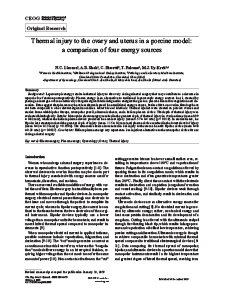Thermal Injury to the Ovary and Uterus in a Porcine Model: A Comparison of Four Energy Sources
ITEM TYPE:
Journal Article
AUTHORS:
N.C. Llarena, A.B. Shah, C. Biscotti, T. Falcone, M.J. Uy-Kroh
ABSTRACT:
Background: Laparoscopic energy results in thermal injury to the ovary during adnexal surgery that may contribute to a decrease in reproductive function postoperatively. Plasma energy is an alternative to traditional laparoscopic energy sources that is created by passing an inert gas over an electrically charged surgical blade designed to energize the gas to a plasma stream for coagulation and dissection. Data suggest that plasma may have less thermal spread than traditional energy sources, but its effects on ovarian histology have not been compared to other electrosurgical modalities.
Materials and Methods: Thermal injuries were created on porcine ovaries and uterine horns with bipolar forceps, monopolar pencil, ultrasonic shears, and a helium plasma device. The depth of thermal injury was evaluated histologically. Results: Monopolar electrosurgery resulted in the greatest depth of thermal injury in ovarian tissue (mean 0.99 ± 0.82 mm), whereas the helium plasma device produced the smallest injury (mean 0.57 ± 0.4 mm) (p = 0.018). In uterine tissue, the bipolar instrument produced the greatest depth of injury (mean 1.15 ± 0.2 mm) and plasma device resulted in the lowest level of injury (mean 0.42 ± 0.13 mm) (p = 0.0002). The ultrasonic shears also resulted in less injury to the uterus than the bipolar device (mean 0.48 ± 0.23 mm) (p = 0.0027).
Conclusion: Helium plasma energy may represent a less injurious alternative to the monopolar device for use during adnexal surgery.
APYX® MEDICAL DISCLOSURES:
FINANCIAL & CONTENT DISCLOSURE
Bovie® Medical (now Apyx Medical) funded this literature. The opinions contained herein are those of the authors(s) and do not necessarily represent the official position or policies of Apyx Medical, Inc.
MANUFACTURING DISCLOSURE
Apyx Medical manufactures and owns the Renuvion®/J-Plasma® technology discussed in this article.
INDICATIONS FOR USE & INTENDED USE DISCLOSURES
- The Renuvion Precise, Precise Open, and J-Plasma Handpieces are intended to be used with compatible electrosurgical generators for the delivery of radiofrequency energy and/or helium plasma for cutting, coagulation, and ablation of soft tissue during open surgical procedures.
- Apyx Medical wants to present to you with current scientific discourse.
RISKS
- Risk associated with the use of the device may include: Helium embolism into the surgical site due to inadvertent introduction into the venous or arterial blood supply system, unintended burns (deep or superficial), pneumothorax, temporary or permanent nerve injury, ischemia, fibrosis, infection, pain, discomfort, gas buildup resulting in temporary and transient crepitus or pain, bleeding, hematoma, seroma, subcutaneous induration, pigmentation changes, increased healing time, and/or unsatisfactory scarring. There may be additional risks associated with the use of other devices along with Renuvion/J-Plasma and there may be an increased risk for patients who have undergone prior surgical or aesthetic procedures in the treatment area.
As with any procedure, individual results may vary. As with all energy devices there are inherent risks associated with its use, refer to the IFU for further information.



